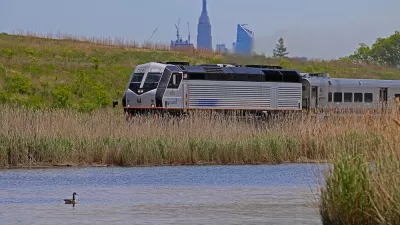WNYC's Andrea Bernstein speaks to "super-commuters", who travel regularly from home to work by air, and uncovers a new way of thinking about where we live and where we work.
The commuter mode split for New York City looks different in the most recent census than it did a decade ago. Notably, some 4,000 commuters hop a plane to work, a demographic that didn't even appear in previous census data. Director of NYU's Rudin Center, Mitchell Moss notes that this growing trend indicates a collapse of regional boundaries as distance is no longer seen as a barrier.
Major shifts in the economy and technology are driving the acceptance of regular air commuting. While much of the country has seen job loss, New York City is still full of high paying jobs. The cost of living in the City remains high, however, and, more importantly, home values elsewhere have fallen to the extent that many families that might have moved are stuck with homes they can't sell. Job insecurity is another justification for super-commuting, as families resist uprooting with each job change.
Advances in technology has also enabled air commuting. A variety of communication and social networking devices make it easier to stay connected to friends and family while traveling. Additionally, widespread internet access means people don't have to be at the office to connect to work. Super-commuter, Dave Gustafson, points out that he "never set(s) the ‘Out-of-Office' reply on my email. I'm never really out of the office."
Gustafson describes another benefit of his air commute which points to a shift in our concept of home, office and belonging to a place:
"Because I travel like this I'm not locked into living in a particular area. We're talking about relocating to another part of the country, and I don't have to find a new job, so long as I'm near an airport. We can pick our place."
Thanks to Jessica Brent
FULL STORY: Air Commuters Growing in Number

Maui's Vacation Rental Debate Turns Ugly
Verbal attacks, misinformation campaigns and fistfights plague a high-stakes debate to convert thousands of vacation rentals into long-term housing.

Planetizen Federal Action Tracker
A weekly monitor of how Trump’s orders and actions are impacting planners and planning in America.

In Urban Planning, AI Prompting Could be the New Design Thinking
Creativity has long been key to great urban design. What if we see AI as our new creative partner?

The Vast Potential of the Right-of-Way
One writer argues that the space between two building faces is the most important element of the built environment.

Florida Seniors Face Rising Homelessness Risk
High housing costs are pushing more seniors, many of them on a fixed income, into homelessness.

Massachusetts Budget Helps Close MBTA Budget Gap
The budget signed by Gov. Maura Healey includes $470 million in MBTA funding for the next fiscal year.
Urban Design for Planners 1: Software Tools
This six-course series explores essential urban design concepts using open source software and equips planners with the tools they need to participate fully in the urban design process.
Planning for Universal Design
Learn the tools for implementing Universal Design in planning regulations.
Gallatin County Department of Planning & Community Development
Heyer Gruel & Associates PA
JM Goldson LLC
City of Camden Redevelopment Agency
City of Astoria
Transportation Research & Education Center (TREC) at Portland State University
Jefferson Parish Government
Camden Redevelopment Agency
City of Claremont




























